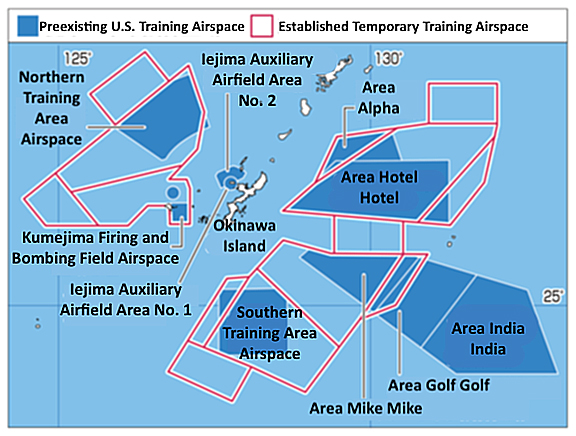U.S. training airspace around Okinawa expanded under guise of temporary use, impeding civil aviation

March 26, 2018 Ryukyu Shimpo
By Ryota Shimabukuro and Ryota Nakamura
Over the past two years U.S. military training airspace around Okinawa has greatly expanded, restricting the navigation of civilian aircraft.
The U.S. military added to its preexisting training airspaces in the form of temporary training airspaces under an Altitude Reservation (ALTRV) to be used as needed. In reality, the ALTRV airspaces became a constant provision to the U.S. military.
The preexisting U.S. military training airspace is mostly contained within the temporary airspace.
According to aviation personnel, almost every day the U.S. military claims official use of ALTRV airspace, and the passage of civilian aircraft is restricted.
However, because the U.S. military sought these training airspaces under the guise of being “temporary,” the scope of the airspaces were not indicated on charts provided to the Okinawa Prefectural Government and other bodies.
It appears that the scope of airspace actually used for U.S. military training is about 60 percent larger than the airspace designated for U.S. military training.
The Ministry of Land, Infrastructure, Transport and Tourism (MLIT) established the ALTRV airspaces under the pretense that they were for use by the Japan Self-Defense Forces (SDF). Initially, the Air Self-Defense Force (ASDF) denied that the U.S. military would use the ALTRV airspaces.
Later the ASDF admitted the airspaces were for joint use with the U.S. military, and that it was not at liberty to discuss whether the U.S. military was using the airspaces independently.
According to several persons involved in aviation, the U.S. military is using these airspaces on a daily basis.
These ALTRV airspaces were established in December 2015.
The U.S. military has established ALTRVs in the past, but it is unusual for it to establish such an expansive ALTRV to the extent that it encompasses preexisting training airspace.
In Kadena Air Base’s Range Planning and Operations documents released on December 28, 2016, its review of training airspace in Okinawa described the airspaces being used by the U.S. military as a “Stationary ALTRV.”
Kadena Air Base authorities acknowledged that the airspaces were established under an ALTRV, but in terms of the frequency of their use, stated that due to security-related reasons it could not disclose particulars about training.
The base’s authorities also claimed that due to the U.S.-Japan Status of Forces Agreement, they could not comment on the timeframe or contents of the training airspace review mentioned in base documents.
However, U.S. military activity in the temporary training airspaces and the timeframe of such use is specified in the aviation data referenced by air-traffic control personnel and pilots.
When the MLIT, which manages airspace, was asked if the U.S. military was using the temporary airspaces, it mentioned not fully knowing the situation.
However, it later corrected its comment for the media, stating that the U.S. military has permission to use the ALTRV airspaces.
The MLIT stated that what it meant is that it does not fully know who is in the airspace or their activities.
An official of the MLIT said, “We have received appeals from civil aviation personnel, asking for reduction of training airspace for the purpose of flight safety. That would be a move in the opposite direction.”
(English translation by T&CT and Erin Jones)
Previous Article:Protesters demand a reversal of peace-leader Hiroji Yamashiro’s sentence at demonstration in front of the Japanese Embassy in Washington D.D.
Next Article:Information wanted for a discovered pen case with name “Masao Uema”
[Similar Articles]
- Civilian aircraft not permitted in Iejima training airspace despite 1985 U.S.-Japan agreement
- Camera drops from U.S. military helicopter
- Ie Village mayor speaks up about scope of U.S. parachute drop training in Okinawa
- Getting a pilot license in Okinawa
- US Marines to expand special-use airspace over Central Training Area in Okinawa
 Webcam(Kokusai Street)
Webcam(Kokusai Street)


